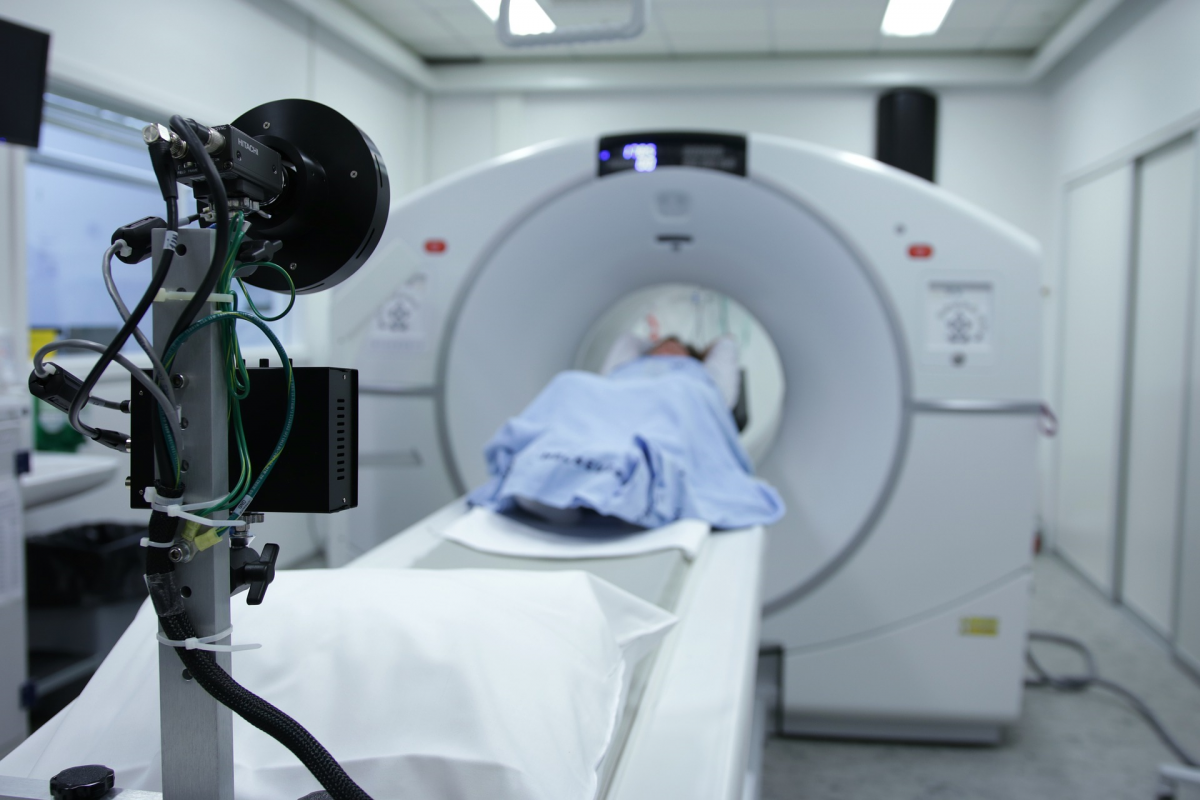Notes: The following information is intended for health care professionals. Always read the label and follow the instructions for use. For information on the efficacy and the side effects, refer to the instructions for use. Products are only for sale to health professionals.
There are many types of computer navigation that can be used in total hip arthroplasty (THA), with several factors influencing surgeons’ uptake (or not) of navigation.
Types of Computer Navigation
Computer navigation systems for THA fall into three broad groups: two image-based groups (using either pre-operative computed tomography (CT) or intraoperative fluoroscopy) and imageless navigation1. Imageless systems rely on a registration process, often involving palpating bony landmarks to locate the patient in 3D space1.
Adoption of Computer Navigation
We have previously discussed that:
- The orientation of the acetabular cup affects THA outcomes,
- The accurate placement of the acetabular cup is difficult and often imprecise,
- Using navigation to improve the placement of the acetabular cup is associated with reduced risks of revision surgery and dislocation.
Despite such evidence, the uptake of computer navigation in THA remains low, accounting for only 4.4% of Australian and 1.8% of US surgeries2, 3. This reluctance of surgeons to embrace navigation may result from concerns such as the cost, time, and complexity that computer navigation may add to the surgical process.
Infection Risk
While navigation is intended to improve surgical outcomes, some navigation systems increase the risks of infection. Infection risk is related to sterility during surgery. When patient registration uses landmarking, the surgeon must access the required bony landmarks. Locating these landmarks through draping can be difficult, particularly in the lateral position, and may compromise sterility4. Similarly, navigation systems that require cleaning and re-sterilisation have an infection risk associated with those procedures5. The Navbit Sprint System does not require landmarking and is provided sterile.

Image by Gerd Altmann from Pixabay
Radiation Availability
With respect to radiation, some image-based navigation systems rely on pre-operative CT scans or intraoperative fluoroscopy scans1. These scans are not always available or rebated. The Navbit Sprint System does not require intraoperative fluoroscopy, and the surgeon can choose whether to use imaging before and/or after surgery.

Image by Bokskapet from Pixabay
Cost
In deciding whether to use navigation, hospitals and surgeons are likely to consider the cost that navigation will add to surgery. Current navigation systems are generally large, re-usable systems that use x-ray, robotic, optical, and/or sensor technologies. These systems generally require capital outlay and payment per patient for consumables. Physically bulky, they also incur costs for cleaning, handling, re-sterilisation, and storage, and they usually require a specialist operator. The Navbit Sprint System is simple, disposable, and provided sterile, and therefore has no capital, maintenance, logistics, cleaning, or in-hospital sterilisation costs, and does not require additional personnel.

Image by Gerd Altmann from Pixabay
Time
Time added to surgical planning and delivery is another consideration for both hospitals and surgeons.
Computer navigation systems tend to increase operative time by about 20 minutes due to setting up equipment, repositioning the patient after landmarking, and using the navigation during surgery. A meta-analysis of 13 studies found that computer navigation added an average of 19.87 minutes the operation time for THA compared with conventional techniques6. Robotics-assisted surgical methods in THA can increase surgical time by up to 49 minutes7. However, there is much variation between studies, and a meta-analysis found that the overall mean increase in time for robotic navigation was 20.72 minutes7, which is similar to the non-robotic navigation increase in surgical time.
Computer navigation has also been associated with a learning curve, with surgery times decreasing significantly with training and experience1, 9, 10. For knee arthroplasty, the learning curve was estimated to be 16 to 20 cases1. In THA, with experience, the time added by imageless systems can be low. For example, a study of a single high-volume surgeon with 57 consecutive patients found an average increase in surgical time of 2.9 minutes11.
A study on the Navbit Sprint System assessed the device with a group of 15 orthopaedic surgeons who were relatively inexperienced in using computer navigation8. Of the 15 participants, 7 had not previously used computer navigation, and the remaining 8 had completed from 3 to 100 navigated surgeries in the preceding 12 months (with an average of 34). All surgeons were trained via an instructional video that simulated the training typically provided by a sales representative. Therefore, this study included users who were early in their learning curve. Even so, the time added by the Navbit Sprint System was estimated to be 7 minutes8.
Some computer navigation systems add preparation time due to imaging and planning prior to surgery9, 12. For the Navbit Sprint System, pre-surgical imaging and planning are optional.
Post-surgically, some navigation systems require further time for cleaning and sterilising any reusable equipment. The Navbit Sprint System is single-use and provided sterile, meaning that there is no cleaning or sterilisation time.

Image by Nile from Pixabay
Complexity
With respect to complexity, surgery is already cognitively demanding. Complex navigation systems add further cognitive load, require time for training, and add potential human error1.
The Navbit Sprint System is simple. In usability testing, surgeons rated the Navbit Sprint System as highly usable (9/10) after watching a short training video8.

Image by Gerd Altmann from Pixabay
Summary
Computer navigation systems for THA can be designed with reduced infection risk, radiation requirements, cost, time, and complexity.
References
- Feng JE, Anoushiravani AA, Eftekhary N, et al. Techniques for Optimizing Acetabular Component Positioning in Total Hip Arthroplasty: Defining a Patient-Specific Functional Safe Zone. JBJS Rev 2019;7(2):e5. doi: 10.2106/jbjs.Rvw.18.00049
- Bohl DD, Nolte MT, Ong K, et al. Computer-Assisted Navigation Is Associated with Reductions in the Rates of Dislocation and Acetabular Component Revision Following Primary Total Hip Arthroplasty. J Bone Joint Surg Am 2019;101(3):250-56. doi: 10.2106/JBJS.18.00108
- Agarwal S, Eckhard L, Walter WL, et al. The Use of Computer Navigation in Total Hip Arthroplasty Is Associated with a Reduced Rate of Revision for Dislocation: A Study of 6,912 Navigated THA Procedures from the Australian Orthopaedic Association National Joint Replacement Registry. JBJS 2021;103(17):10.2106/JBJS.20.00950. doi: 10.2106/jbjs.20.00950
- Davis ET, Schubert M, Wegner M, et al. A new method of registration in navigated hip arthroplasty without the need to register the anterior pelvic plane. J Arthroplasty 2015;30(1):55-60. doi: 10.1016/j.arth.2014.08.026 [published Online First: 2014/10/15]
- ISO 17665-1:2006(en) Sterilization of health care products — Moist heat — Part 1: Requirements for the development, validation and routine control of a sterilization process for medical devices.
- Xu K, Li Y-m, Zhang H-f, et al. Computer navigation in total hip arthroplasty: A meta-analysis of randomized controlled trials. International Journal of Surgery 2014;12(5):528-33. doi: https://doi.org/10.1016/j.ijsu.2014.02.014
- Han PF, Chen CL, Zhang ZL, et al. Robotics-assisted versus conventional manual approaches for total hip arthroplasty: A systematic review and meta-analysis of comparative studies. Int J Med Robot 2019;15(3):e1990. doi: 10.1002/rcs.1990 [published Online First: 2019/02/13]
- Walter WL, Baker NA, Marsden-Jones D, et al. Novel measure of acetabular cup inclination and anteversion during Total Hip Arthroplasty. 2022 doi: 10.2147/MDER.S339669
- Kayani B, Konan S, Ayuob A, et al. The current role of robotics in total hip arthroplasty. EFORT Open Rev 2019;4(11):618-25. doi: 10.1302/2058-5241.4.180088 [published Online First: 2019/11/23]
- Thorey F, Klages P, Lerch M, et al. Cup positioning in primary total hip arthroplasty using an imageless navigation device: is there a learning curve? Orthopedics 2009;32(10 Suppl):14-7. doi: 10.3928/01477447-20090915-52 [published Online First: 2009/10/27]
- Christ A, Ponzio D, Pitta M, et al. Minimal Increase in Total Hip Arthroplasty Surgical Procedural Time with the Use of a Novel Surgical Navigation Tool. Open Orthop J 2018; 12. https://doi.org/10.2174/1874325001812010389 (accessed 2018).
- Kouyoumdjian P, Mansour J, Assi C, et al. Current concepts in robotic total hip arthroplasty. SICOT-J 2020;6:45